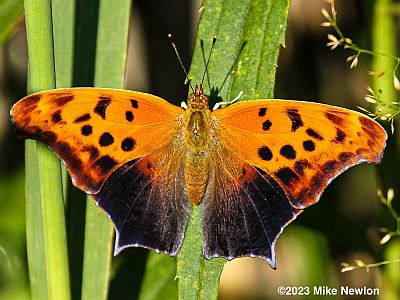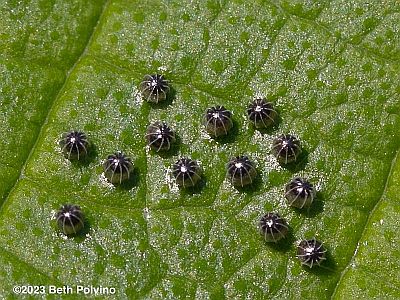New Jersey Butterfly Club
A chapter of the North American Butterfly Association (NABA)
Question Mark
Polygonia interrogationis
Identification: Medium—2.5” Wing edges distinctly irregular, with FW strongly hooked at tip and HW tailed. Above (light form): FW bright orange, with many black spots, including a line of 3 round dots capped by a horizontal dash. HW mostly darker, with a few black spots at base and submarginal pale spots. When fresh, trailing edges of wings are bordered in bright lilac. Above (dark form): FW same as light form, but HW mostly blackish, with some orange near base; spotting variably obscured. Below: FW and HW range from rather plain, light grayish-brown (sometimes with pale violet overtones) to strikingly mottled in shades of dark and light brown. HW with silvery mark in center consisting of a short, curved line and a separate dot, forming a "question mark." This mark separates it from Eastern Comma, which lacks the dot and thus displays a "comma"; also, Eastern Comma lacks the horizontal dash in apex of FW above. Question Mark is larger than Comma and wing margins are less scalloped.
NJ Status and Distribution: Resident. Fairly common and widespread throughout.

Habitat: In and near woods, where it is usually seen on bare ground, leaf litter, or tree trunks. Sometimes found nectaring in fields and in gardens, especially near woods, but usually found at sap runs, moist ground, or even carrion and dung.
Flight Period: Two broods over most of the state. Adults overwinter, begin flying in March (south) and April (north), and produce “dark form” offspring that emerge largely in May-July. This summer brood’s “light form” offspring in turn fly from late August into October (north) and November (south), then hibernate. Southward migration in fall is notable, particularly along the coast, and a less-obvious northward movement occurs in spring. The timing and intensity of this immigration varies greatly. Extreme dates: North Jersey 3/9—12/31; South Jersey 1/7—12/18.
Caterpillar Food Plants: Nettles (Urtica), elms (Ulmus), and hackberries (Celtis).
Overwintering Stage: Adult.
Good Locations: Unpaved roads in Delaware Water Gap GNRA (where sometimes many dozens can be seen in a few hours); Whittingham WMA parking lots and woods roads; Cape May Point SP.
Comments: The lavender border on the trailing edge of both wings of a fresh QM never fails to elicit oohs and aahs from appreciative butterfliers. As with most “true brushfoot” species, populations fluctuate greatly.

Dark form, Glenhurst Meadows, Somerset Co., NJ, 7/17/11.

Light form, Glenhurst Meadows, Somerset Co., NJ, 9/25/11.

A much lighter example of a light-form Question Mark. Cape May Co., NJ, 9/23/17.

Mottled form, Kittatinny Valley SP, Sussex Co., NJ, 7/4/06.

Plain form, White Lake NA, Warren Co., NJ, 9/24/15.

Eggs. In some cases, eggs are deposited in stacks rather than individually.

Late instar caterpillar of Question Mark.

Stinging nettle (U. dioica), a caterpillar food plant for Question Mark.